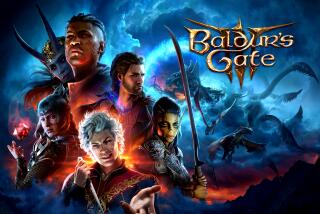‘Gate’ Opens ‘Dungeons and Dragons’ Realm to Generations of Players
Interplay’s hit series “Baldur’s Gate” has sold hundreds of thousands of copies and won fans worldwide among adventure-game enthusiasts. James Ohlen and Kevin Martens of development house BioWare served as lead designers on “Baldur’s Gate,” “Baldur’s Gate II: Shadows of Amn” as well as the upcoming expansion pack “Baldur’s Gate II: Throne of Bhaal.”
Q: How big a part did “Baldur’s Gate” play in making “Dungeons and Dragons” hip again?
Ohlen: “Baldur’s Gate” was a game that anyone could play, from casual gamer to die-hard fan. “Baldur’s Gate” allowed all of the older fans to play “Dungeons and Dragons” again as well as introducing more people to the system. It didn’t require other players, and you didn’t need to plan for eight-hour-long gaming sessions.
Q: Compared with previous role-playing games, “Baldur’s Gate” was a technical marvel. Why had no one achieved such a feat before?
Ohlen: The reason that “Baldur’s Gate” was successful was because it appealed to the strategy/action gamer. Many of the role-playing games that came out before it were slow-paced games, often involving a turn-based combat system. “Baldur’s Gate” re-created the “Dungeons and Dragons” experience and made it fast-paced without diluting the rules or strategy.
Q: Are staff production meetings just a cover story for lengthy gaming sessions?
Martens: If only! Here at BioWare, we routinely bite off more than we can chew. Hence, enormous, complex games like “Baldur’s Gate II: Shadows of Amn.” We always have a million things to do as we desperately try to get each of these monsters out the door in time, bug-free and fun.
Q: Do team members have extensive experience with tabletop gaming?
Ohlen: Almost everyone who worked on the “Baldur’s Gate” title played “Dungeons and Dragons” at one time or another. Currently, there are two “Dungeons and Dragons” campaigns being run in the office. One of those campaigns is a continuation of a campaign world that has been going on for about a decade.
Q: What is the scope of such an immense project?
Ohlen: The following stats are for “Baldur’s Gate II.” We had about 30 people full time on the project for 16 months (with some preliminary work done 4 months before the official start date). There were about 800,000 lines of code and 1.1 million words of dialogue.
Q: Who wrote the volumes of in-game text, and how big a feat was it?
Martens: Our writers are, in no particular order, Luke Kristjanson, David Gaider, James Ohlen, Kevin Martens, Rob Bartel and Drew Karpyshyn. “Baldur’s Gate II: Shadows of Amn,” for example, had over a million words of dialogue split up among several thousand unique characters and up to 300 hours of game play [depending on how thorough the player wants to be]. This equals around 100 unique subplots as well as a deep main story. I would say that it was quite the feat.
Q: Did technical limitations ever make it necessary to bend pen-and-paper rules?
Ohlen: Yes. The “Dungeons and Dragons” rules are very extensive and were meant for a turn-based tabletop game. What we tried to do was adapt the rules in such a way that would still give the player the feeling that he was playing “Dungeons and Dragons.” If a rule wouldn’t be noticed by 95% of the players, then we’d mark it as one that we could fiddle with in order to get the game out the door. We try to follow the spirit of the rules, rather than the exact description.
Q: What does the game offer that traditional role-playing games don’t?
Martens: Unlike pen-and-paper games, our games add both visuals and audio to the experience, greatly increasing the immersion. To use an analogy, playing “Baldur’s Gate II: Shadows of Amn” is like watching a movie without losing the detail of a book.
Q: What are some highlights of the design experience?
Martens: The best part of designing a quest is seeing the comments of fans in e-mail or message boards as they play through and get caught up in the story that we’ve created. That we can actually bring emotion to a player and have them relate on a personal level to a plot or character in the game is truly gratifying.
Scott Steinberg is a freelance writer specializing in video games.
More to Read
The biggest entertainment stories
Get our big stories about Hollywood, film, television, music, arts, culture and more right in your inbox as soon as they publish.
You may occasionally receive promotional content from the Los Angeles Times.










